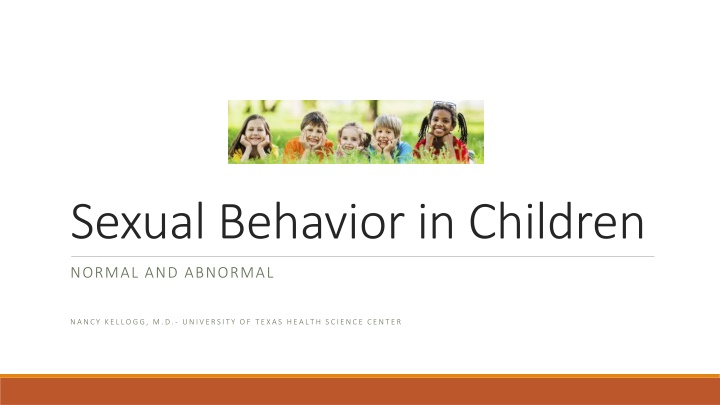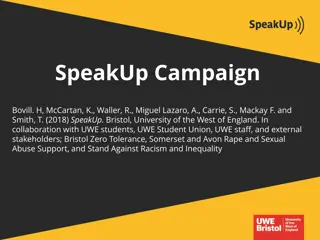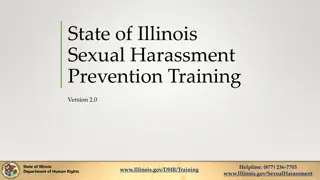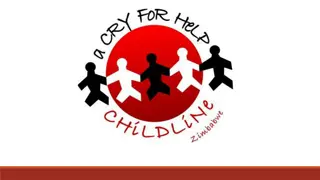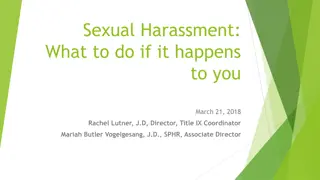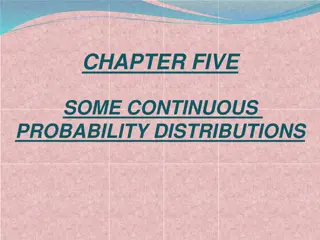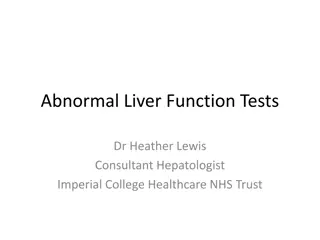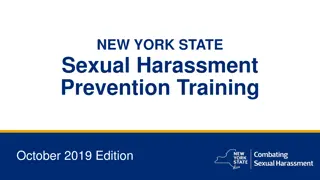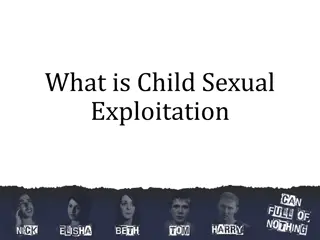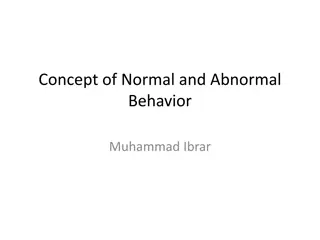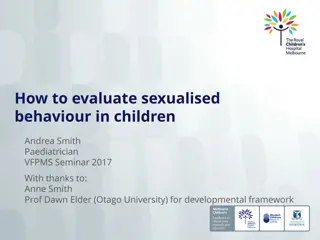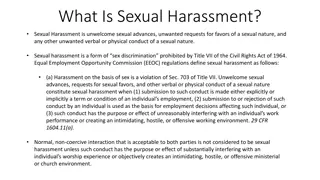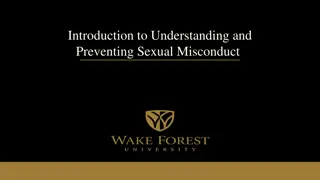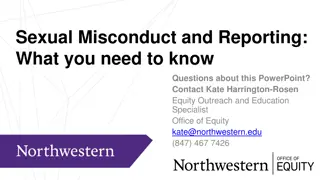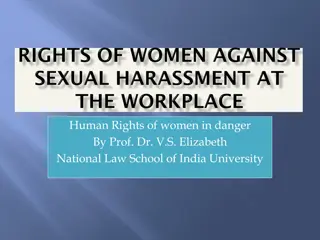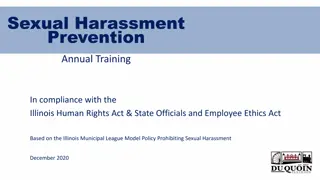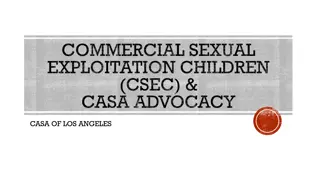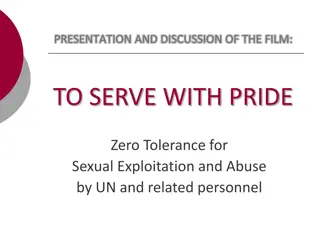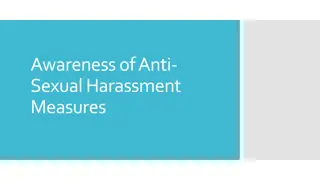Sexual Behavior in Children: Normal vs Abnormal
This content delves into the complex topic of sexual behavior in children, exploring both normal and abnormal patterns. It discusses the influence of media, trends in sexual abuse, and types of behaviors observed, providing insights into developmental appropriateness and signs of potential risk factors. The content also covers age-specific behaviors and highlights the importance of understanding and addressing these sensitive issues.
Download Presentation

Please find below an Image/Link to download the presentation.
The content on the website is provided AS IS for your information and personal use only. It may not be sold, licensed, or shared on other websites without obtaining consent from the author.If you encounter any issues during the download, it is possible that the publisher has removed the file from their server.
You are allowed to download the files provided on this website for personal or commercial use, subject to the condition that they are used lawfully. All files are the property of their respective owners.
The content on the website is provided AS IS for your information and personal use only. It may not be sold, licensed, or shared on other websites without obtaining consent from the author.
E N D
Presentation Transcript
Sexual Behavior in Children NORMAL AND ABNORMAL NANCY KELLOGG, M.D. - UNIVERSITY OF TEXAS HEALTH SCIENCE CENTER
Sexual Abuse Trends Since 1995, sexual abuse numbers are trending down Approximately 70,000 children per year in the U.S. are validated victims of sexual abuse
Media Influence Children spending 6-8 hours a day exposed to some form of media Television: 8 sexual acts per hour (compared to <2/hr in 1976) Clothing (e.g. Abercrombie and Fitch): Clothes line for girls 7-14 include thong underwear with Eye Candy and Wink Wink near the crotch A larger and younger generation of sexual savvy youth
Sex and Cell Phones Study of 3477 law enforcement cases (2008-09) 63% of sexual images transmitted by cell phone An adult was involved in 36% Telephone survey of 1560 youth ages 10-17 7% had received nude or nearly nude images of others 1% appeared in or created nude images or videos
Types Solitary Behaviors Behaviors involving others Purpose: Gratification Self-soothing Curiosity Imitation Attention-seeking
Normal sexual Behaviors Developmentally appropriate and expected No risk factors for abuse are observed Other terms: sexualized behavior or sexual play
Normal: Ages 6-9 High frequency (14-40%) Touches genitals at home Tries to look at people when they are nude Stands/sits too close to others Touches mother s breast
Normal: Ages 6-9 Low Frequency (8-14%) Very interested in opposite sex Knows more about sexual topics Tries to look at pictures of nude people in books or T.V. Talks about sexual topics Dresses like opposite sex Masturbates with hand
Normal: Ages 10-12 High Frequency (9-29%) Very interested in opposite sex Wants to watch/view nudity on television and other media Knows more about sexual topics Touches sex parts at home Lower Frequency (5-8%) Stands/sits too close Tires to look at people when they are nude Talks about sex acts Talks flirtatiously Dresses like opposite sex
Sexual Behavior Problems Children 12 and younger who Initiate behaviors involving sexual body parts (i.e., genitals, anus, buttocks or breasts) that are developmentally inappropriate or potentially harmful to themselves or others (Association for the Treatment of Sexual Abusers, 2006) Developmentally Inappropriate Occur at a greater frequency than seen in normative groups Occur at a much earlier age than would be expected Become a preoccupation for the child Persist/reoccur after adult intervention Potential Harm Coercion or cause physical injury or emotional distress
Examples of SBPs in Children Any sexual behavior that involve children who are 4 or more years apart A variety of sexual behavior displayed on a daily basis Sexual behavior that results in emotional distress or physical pain in at least one child Coercion or threats to another child to participate Persistent behaviors resistant to adult redirection and child becomes angry if distracted Explicit repetitive acts involving actual penetration or oral-genital contact Asking an adult to perform a sexual act American Academy of Family Physicians, 2010
Associated Disorders with SBPs in Children One study showed 96% of children with sexual behavior problems had an additional psychiatric diagnosis 76% Conduct Disorder 40% ADHD 27% ODD Externalizing behavior problems strongly associated in children Lower self-esteem and peer acceptance
Adolescent Sexual Behavior Adult Response Required Sexual preoccupation/anxiety that interferes with daily functioning Pornographic interest Promiscuity/multiple sexual partners Sexually aggressive themes or obscenities Sexual graffiti that is chronic or affects others Embarrassment of others with sexual themes Violations of other s body space, such as pulling down pants, pulling up shirt Single occurrence of peeping, exposing or frottage (rubbing against others sexually)
Adolescent Sexual Behavior Correction or Professional Intervention Compulsive masturbation Degradation/humiliation of self or others with sexual themes Chronic preoccupation with sexually aggressive pornography Sexually explicit conversation with significantly younger children Touching genitals without permission ( goosing tapping ) Sexually explicit threats
Adolescent Sexual Behavior Illegal Behavior requiring immediate intervention Obscene phone calls, voyeurism, exhibitionism, or frottage Sexual contact with someone of significant age or power difference Forced sexual contact Forced penetration Sexual contact with animals Genital injury to others
FACT If children receive a cognitive-behavioral therapy intervention, their risk of becoming a sex offender is no more than that of children with ADHD (Carpenter, Silovsky & Chafin, 2007)
Principles of Management for SBPs Gather information about the behavior from multiple sources Focus on what current factors are maintaining current behavior rather than the initial causes or past behavior Cognitive-behavioral and psycho-educational interventions involving the children, parents, and teachers are very effective (even short term therapy) Do Not push the sexual abuse agenda if a child does not disclose abuse
Reporting Suspected Abuse If Child gives a history that they have been sexually or physically abused If Child gives a history that they have had sexual contact with a child 4 or more years older or younger, or contact is otherwise abusive, or If a child has injuries that are suspicious for sexual or physical abuse Report neglect if a parent intentionally exposes child to harmful pornographic material or Parent fails to modify environment to reduce the child s access to sexually explicit material despite medical or mental health advice
FECC Assessment Tools Child Sexual Behavior Inventory CSBI Child Sexual Behaviors, 21 Problematic Characteristics CSB21 Juvenile Sexual Offense Recidivism Risk Assessment Tool, 2ndEdition JSORRAT-II Juvenile Culpability Assessment JCA Sexual Behavior and Attitude Interview Trauma Symptoms Checklist for Children -TSCC Trauma Symptoms Checklist for Young Children TSCYC
